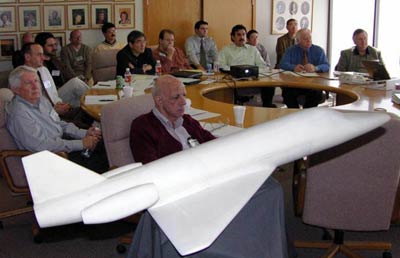Rocket plane venture star (part 3)<< page 1: a tour of Rocketplane Certification and licensingTSR: So have you qualified airplanes for FAA certification? Urie: In the past I have yes. TSR: I think Burt Rutan’s Starship got certified. Urie: The Beech Starship? TSR: I think so. You don’t think he has a broad enough base to qualify a space ship. Urie: I think it is a different game. I think I do not want to get involved. Here is a data point. Lockheed spent as many engineering labor hours qualifying the L-1011 as they did designing it. That is just a fact. That is what you do not want to have to do. TSR: So if you can save that, you can design another one. Urie: I would rather avoid it. I will take the chance. I will take the risk of working with AST as they develop their capabilities to license these vehicles. We will learn together. TSR: I am glad that HR 5382 passed. I am glad that AST seems to be doing a great job. Urie: They are very interactive with us. We try to keep them informed of all of our moves. They try to keep us informed of all their changes of thought. It works well. FollowupTSR: Did the life pod that R2-D2 and C-3P0 landed in during Star Wars remind you of your HL-20? I saw the X-38 drop test article in the hangar. What did you think about the ISS when the X-38 got cancelled? Urie: No, but ACRV was close. It’s always risky on the frontier. TSR: Did you dive right in to the SR-71 Skunk Works in 1966? Can you share a declassified anecdote?
Urie: No, I was on later. Tony McPeak shut down the SR when he was chief of staff. Now he is our chairman of the board. I told him it took years for me to learn that his first name wasn’t Goddam. TSR: Could the VentureStar have been a commercial success if it had been fully funded? Are you thinking two stages is the way to go now? Urie: Yes, when the market returns. Two-stage is easier on the engineers, one-stage easier on the financiers. TSR: Does Rocketplane have a plan for orbital? Urie: Yes. TSR: How do you and Mitchell Burnside-Clapp divide duties? Urie: Mitch reports to me. TSR: You’re a pretty low profile guy for someone who has been called the Engineer of the Year. Urie: I am an introvert. TSR: Is Rocketplane kind of the antithesis of SR-71 and X-33? Did the latter reach too far at far too high a risk? Urie: No, just one of the flock. No, it took on reasonable risk with too little funding. TSR: Mitchell says that X-15 avionics was Pleistocene compared to yours. How do you make things safe during reentry? Urie: You mean safer. Converting that much energy can never be safe. TSR: How are you doing pressure containment to avoid single component failure causing a pressure breach? Urie: It is structure: we will burst test one and operate at 40% burst pressure. TSR: Are there cup holders on the seats? Urie: Cocktails served post flight. TSR: Do you want to emigrate to space? Urie: You betcha. TSR: Who are your space heroes? Urie: I am too old for heroes. TSR: Is Oklahoma OK? Do you think it is coincidence that one of the last places colonized on Earth is leading the wave into commercial space? Urie: Sure is, they put us in business. Maybe, but who can say? TSR: What will you do different for mark 2 if you have to build a fleet of 50 rocket planes when it’s a hit? Urie: Start with clean paper. TSR: Does doing a conversion raise your unit cost while lowering your startup cost? What do you get and what do you give up? Urie: Lowers both, we get a rugged hull for less than we could design and build it for. We lose design freedom. TSR: Why are your g-forces on re-entry lower than SpaceShipOne? Urie: We use a higher L/D glide slope, they cannonball in. TSR: How is the spaceport coming on its environmental impact statement? Urie: On track. We work closely with them. TSR: Did you have a role in getting “during the majority of the powered portion of its flight” into HR 5382? Urie: No. TSR: Did you do anything with Starlet/Starlite back in 1967? What’s the difference between a toroidal aerospike and a linear aerospike?
Urie: No. Depends on the shape you’re integrating into. Annular has no tip losses but linear is a more flexible arrangement to design and service. TSR: Any more aerospikes in your future? Urie: I would not be surprised. TSR: What market do you think will be addressed first, terrestrial point-to-point or orbital? Urie: Orbital, probably but my favorite is space flight to a busy planet. TSR: What is your testing strategy? Urie: Thorough, methodical envelope expansion. TSR: Is a $40 million project easier or harder than a $900 million project? Urie: Harder. Everybody multitasks and there is no place to hide. TSR: What do you think the most surprising engineering achievement of 20th century was? Urie: The application of quantum electrodynamics to electronic and photoelectric devices. TSR: With such talent, I figure you could have had your pick of programs. Did you consciously avoid working on weapons delivery systems? Urie: I have done my share. There were not any on the menu this time. TSR: What do you think the chances are of humanity filling the galaxy? Urie: About the same as Bhutan conquering the world. Home |
|
